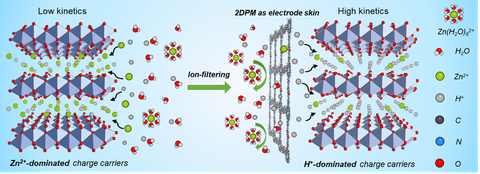Mar 29, 2024
Proton-Selective Coating Enables Fast-Kinetics High-Mass-Loading Cathodes for Sustainable Zinc Batteries
2D polyimine nanomembrane with high ion selectivity enables a high-kinetics electrochemistry transition for aqueous zinc batteries
Research: The pressing need for sustainable and scalable energy storage solutions has spurred the burgeoning development of aqueous zinc batteries (AZBs). However, the presence of kinetics-sluggish Zn2+ as the dominant charge carriers in AZB cathodes leads to suboptimal charge-storage capacity and durability, which poses a significant hurdle in the practical implementation of AZBs.
The scientists from TU Dresden and MPI Halle, together with collaborators, discover that an ultrathin 2D polyimine membrane (2DPM) featured by dual ion-transport nanochannels and densely distributed proton-conduction groups facilitates rapid and selective proton passing within the typical AZB electrolyte medium. Permeation measurements reveal 2DPM with a high H+ flux exceeding 0.9 mol m−2 h−1 and an excellent H+/Zn2+ transport selectivity of 140.7. Consequently, we achieve a distinctive electrochemistry transition shifting from sluggish Zn2+-dominated to fast-kinetics H+-dominated Faradic reactions within high-mass-loading AZB cathodes by using 2DPM as an interfacial coating. Combining 2DPM with a NaV3O8·1.5H2O cathode (10 mg cm−2) maximizes the realization of theoretical capacity (increasing from 288.8 to 450.5 mAh g−1). More importantly, the electrode shows an exceptionally high areal capacity of 4.5 mAh cm−2 and state-of-the-art energy density of 33.8 Wh m−2, along with enhanced cycling stability (68.6% vs. 87.8% after 1,000 cycles). Using the 2DPM coating, they further demonstrate the interfacial proton-selective transport for different cathodes (e.g., ε-MnO2 and α-MoO3) and varying aqueous electrolytes (e.g., 2 M ZnSO4 and 20 m ZnCl2), validating its universality for developing reliable aqueous batteries.
Acknowledgements: This work was financially supported by European Union’s Horizon Europe research and innovation programme (ERC Starting Grant, BattSkin, 101116722), European Union’s Horizon 2020 research and innovation programme (LIGHT-CAP 101017821), the ERC Consolidator Grant (T2DCP, NO. 819698), German Research Foundation (DFG) within the Cluster of Excellence, CRC 1415 (Grant No. 417590517), and Polymer-based Batteries (SPP 2248, RACOF-MMIS). The authors acknowledge the use of the facilities in the Dresden Center for Nanoanalysis (DCN) at the Technische Universität Dresden, the GWK support for providing computing time through the Center for Information Services and High-Performance Computing (ZIH) at TU Dresden, beam time allocation at beamline P02.1 and P65 at the PETRA III synchrotron (DESY, Hamburg, Germany), and beam time allocation at beamline 3C SAXS-I and 9A U-SAXS at the Pohang Accelerator Laboratory (PLS-II).
Reference: Guo, Q., Li, W., Li, X. et al. Proton-selective coating enables fast-kinetics high-mass-loading cathodes for sustainable zinc batteries. Nat. Commun. 15, 2139 (2024). https://doi.org/10.1038/s41467-024-46464-9

